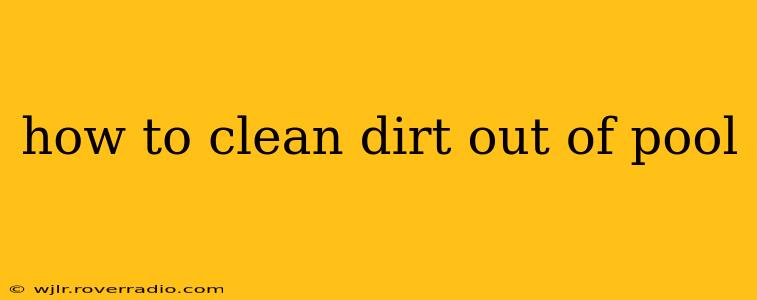Keeping your pool sparkling clean is essential for enjoyable swims and maintaining the longevity of your pool equipment. Dirt, leaves, and other debris can quickly accumulate, impacting water clarity and potentially harming your pool's ecosystem. This guide will walk you through various methods for effectively cleaning dirt from your pool, addressing common concerns and providing expert tips for maintaining a pristine swimming environment.
What Kind of Dirt is in My Pool?
Before diving into cleaning methods, it's crucial to identify the type of dirt contaminating your pool. This helps determine the most effective cleaning approach. Common culprits include:
- Leaves and organic debris: These are often the most visible pollutants, easily skimmed from the surface.
- Fine dirt and dust: Windblown dirt can settle on the pool bottom, requiring vacuuming.
- Algae: Green, brown, or black discoloration indicates algae growth, requiring specific treatment beyond simple cleaning.
- Sand and sediment: This usually comes from heavy rains or nearby construction, settling at the bottom of the pool.
Understanding the source of the dirt helps you choose the right tools and techniques.
How Do I Clean the Dirt From My Pool?
Cleaning your pool involves a multi-step process, usually employing several different techniques:
1. Skimming the Surface
This is the first step in any pool cleaning routine. Use a pool skimmer net to remove large debris like leaves, twigs, insects, and other floating matter. Regular skimming prevents larger items from sinking and becoming more difficult to remove. Empty the skimmer net frequently into a garbage can or designated area.
2. Vacuuming the Pool Floor and Walls
For fine dirt, sand, and sediment on the pool floor and walls, a pool vacuum is essential. There are two main types:
- Manual vacuum: This requires attaching a vacuum head to your pool pole and manually pushing it across the pool floor and walls. This is suitable for smaller pools or occasional cleaning.
- Automatic vacuum: These robotic cleaners operate independently, navigating the pool and cleaning the floor and walls with minimal human intervention. This is ideal for larger pools or those requiring more frequent cleaning.
Remember to pre-vacuum the pool thoroughly to remove larger debris before starting this process.
3. Brushing the Pool Walls and Floor
Brushing loosens dirt and algae clinging to the pool walls and floor, making it easier for the vacuum to remove it. Focus on areas where dirt tends to accumulate, such as corners and steps. Regular brushing prevents dirt build-up and helps maintain a clean pool.
4. Backwashing the Filter
Your pool filter plays a crucial role in removing dirt from the water. Backwashing the filter regularly is vital to maintain its efficiency. Consult your filter's manual for specific instructions, as the process varies depending on the filter type. Backwashing removes trapped debris from the filter media, restoring its filtering capacity.
5. Cleaning the Pool Basket
Regularly inspect and clean the skimmer basket and pump basket. These baskets collect debris before it enters the filter, preventing clogs and ensuring efficient filtration.
How Often Should I Clean My Pool?
The frequency of pool cleaning depends on several factors, including pool size, usage, weather conditions, and the surrounding environment. As a general guideline:
- Skimming: Daily skimming is recommended, especially during periods of high leaf fall or windy weather.
- Vacuuming: Once a week is generally sufficient for most pools, although more frequent vacuuming might be necessary depending on usage and environmental conditions.
- Brushing: Once a week or every other week is usually enough.
- Backwashing: The frequency depends on your filter type and the amount of debris collected. Check your filter pressure gauge regularly. If the pressure rises significantly above the recommended level, it's time to backwash.
What if I Have a Really Dirty Pool?
For severely dirty pools, a combination of the above methods and potentially stronger cleaning chemicals might be necessary. In cases of significant algae growth, you'll likely need algaecide. Always follow the instructions on the product label carefully. Consider contacting a professional pool cleaning service for extremely dirty or neglected pools.
How can I prevent dirt from getting into my pool?
Prevention is key! Here are some proactive steps:
- Regularly clean the surrounding area: Remove leaves and debris from the pool deck and surrounding landscaping.
- Use a pool cover: A pool cover helps keep out leaves, dirt, and other debris when the pool is not in use.
- Install a leaf net: A leaf net prevents larger debris from entering the pool.
By combining regular cleaning and preventative measures, you can keep your pool sparkling clean and enjoy a refreshing swim all season long. Remember to always consult your pool equipment's manuals for specific operating instructions and safety precautions.
